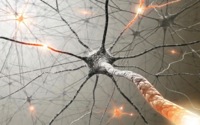Anesthesia
Origin
New Latin, from Greek anaisthēsia insensibility, from a- + aisthēsis perception, from aisthanesthai to perceive
Definitions
- 1: loss of sensation with or without loss of consciousness
Description
Anesthesia, or anaesthesia (from Greek αν-, an-, "without"; and αἴσθησις, aisthēsis, "sensation"), traditionally meant the condition of having sensation (including the feeling of pain) blocked or temporarily taken away. It is a pharmacologically induced and reversible state of amnesia, analgesia, loss of responsiveness, loss of skeletal muscle reflexes, decreased stress response, or all of these simultaneously. These effects can be obtained from a single drug which alone provides the correct combination of effects, or occasionally a combination of drugs (such as hypnotics, sedatives, paralytics and analgesics to achieve very specific combinations of results. This allows patients to undergo surgery and other procedures without the distress and pain they would otherwise experience. An alternative definition is a "reversible lack of awareness," including a total lack of awareness (e.g. a general anesthetic) or a lack of awareness of a part of the body such as a spinal anesthetic. The pre-existing word anesthesia was suggested by Oliver Wendell Holmes, Sr. in 1846 as a word to use to describe this state.
Types of anesthesia include local anesthesia, regional anesthesia, general anesthesia, and dissociative anesthesia. Local anesthesia inhibits sensory perception within a specific location on the body, such as a tooth or the urinary bladder. Regional anesthesia renders a larger area of the body insensate by blocking transmission of nerve impulses between a part of the body and the spinal cord. Two frequently used types of regional anesthesia are spinal anesthesia and epidural anesthesia. General anesthesia refers to inhibition of sensory, motor and sympathetic nerve transmission at the level of the brain, resulting in unconsciousness and lack of sensation. Dissociative anesthesia uses agents that inhibit transmission of nerve impulses between higher centers of the brain (such as the cerebral cortex) and the lower centers, such as those found within the limbic system.[1]
